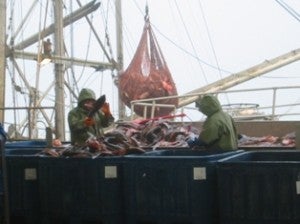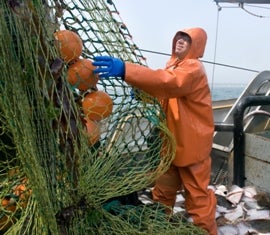Encouraging news from John Sackton at SeafoodNews.com on the implementation of sectors in New England:
SEAFOOD.COM NEWS by John Sackton – May 11, 2010 – Catch shares have come to New England as of May 1st, and contrary to reports of disaster, landings overall are up across the region.
In the first week of May last year (2009), total landings were 981,000 lbs. This year, landings the first week of May totaled 1,020,000 lbs., an increase of 4%, according to the NMFS weekly New England landing summaries. These figures were calculated by comparing the NMFS Weekly Auction report year to date totals for the week ending April 30th, 2010, and May 7th, 2010.
By using the change in the year to date figures for this single week, it is possible to get NMFS’ figures for landings through the Auction for this week in 2009 and the same week in 2010. Both Gloucester and New Bedford saw higher landings in 2010. For Gloucester, 331,000 lbs of fish went through the auction, vs. 249,000 for the same week in 2009. For New Bedford, 689,000 lbs. went through the auction this year, vs. 490,000 for the same week last year. In percentage terms, Gloucester is up 33%, and New Bedford is up 40.6%. The reason that the regional totals are not higher is that in 2009, there were landings recorded for one day in Boston, but in 2010, no landings were made this week in Boston.
So, whatever else is happening in New England, the fleet is landing more fish. Also, reports from boat owners and the auctions show some spectacular results. For example, Carlos Rafael, the largest fleet owner in New England, runs 29 groundfish boats out of New Bedford.
Last week, he was crying crocodile tears, saying “I don’t have enough fish” to the New Bedford Standard Times. Actually, Carlos has landing rights to about 12.28 million lbs. of fish, about 9% of the total New England landings. Most of his fleet is believed to be in the Northeast Sector 9, managed by his daughter, which has allocations of 13.8 million lbs, while additional quota could also be in the Northeast sectors 7 and 8, which also have other boats from New Bedford.
What happened to Carlos during the first week of the program: he landed the highest grossing groundfish trip ever in New Bedford. One of his vessels came in with a gross stock of over $179,000 for one trip. The boat landed haddock, cod, yellowtail, dabs, blackback etc., and because the vessel could keep everything it caught of legal size, the efficiency of the vessel skyrocketed.
It is true that at that rate, Carlos may not need all of his 29 vessels, but on the other hand, his business will be much more profitable this year, as he can determine whether to quickly catch his quota in a few months, or to spread out his trips. But in any case, each trip he is now landing under the new system will be bigger and more profitable than under the old system of trip limits and discards.
Other vessels fishing on Georges Bank confirmed immediate changes in behavior. For example, one captain said that he landed a trip of over 75,000 lbs of haddock, and was able to avoid the the low-quota choke species by altering gear slightly and changing fishing practices.
The numbers for this trip were 140 lbs. of haddock landed for each pound of yellowtail by-catch, and 25 lbs. of haddock landed for each pound of Georges Bank Cod. In April, this same boat had been discarding thousands of pounds of yellowtail.
For this vessel, sustaining anywhere close to these catch ratio’s will allow the vessel to take its full allocation of haddock, an abundant species. This has not happened in New England for years. One of the strongest criticisms of NMFS management has been that huge amounts of target species, especially haddock, had to be left uncaught despite healthy stock levels under the old system.
Under the 2010 system, landings actually will rise, and be higher than in 2007, because a greater percentage of the actual TAC will be caught. What is different? The fishing regime. Instead of having no penalty for discards over trip limits under the old days at sea system, the new fishing regime makes each captain responsible for their own by-catch. In this case, these figures mean that at last, New England vessels will be able to catch much more of the abundant haddock, because they have the flexibility, and the incentive to target species carefully.
Despite the political uproar over catch shares, the basic fact that 20% of the New England vessels land 80% to 85% of the regions’ fish has not changed in ten years. These are the vessels that are most immediately poised to thrive under the new regime, as they will be able to catch a higher total proportion of their quota of abundant stocks. If this group of vessels catches anywhere close to their Annual Catch Entitlements, the total landings in New England will rise, not fall, compared certainly to 2007, and likely to more recent years as well.
There have been a lot of reports of confusion and uncertainty from some of the smaller vessels. Some vessels elected not to fish until they had a better handle on the electronic reporting software. The software used by the Northeast fisheries coalition sectors did not get tested on vessels until just before May 1st, and as a result there are still a number of bugs and problems to work out. Currently Northeast sector members are using thumb drives to transfer data; and computers which require the older version of Windows – XP.
Sectors using the Norwegian based Olfish software report no problems, with the cost being about $800 for the software, and $300 for a new computer to run it on each vessel. The key number to watch in the coming weeks are the landings by species compared to 2009, as reported sold through the auctions. These numbers will tell the real story, and at least for the first week, that story is very positive.












5 Comments
Feudal system-1 New Bedford LA trip boat landed 60,000 pounds of scallops for $500,000. That 60,000 pounds should be supporting a lot of boats, not just one.
Our fleet needs diversity to be sustainable.
Yes, the good news is the fish are back. The most we’ve seen in 30 yrs. Why should a handful of people OWN it?
Why is it wrong for some fishermen to make a profit while others don’t? This happens in almost every other business, but fishermen seem to want to split ‘barely enough’. It would be helpful to know why the fleet “needs diversity to be sustainable”.
Catch Shares is creating a feudal system. Look up regulatory capture, rent seeking, corporate welfare, socialism for the rich & capitalism for the poor. Catch Shares turning fishing into a business is the worse thing you could do. The price of fish will skyrocket once the taxpayers quit footing the bill for observers & monitoring
through catch shares.
Elinor Ostrom won the Economic Nobel prize for debunking the tragedy of the commons. If the stakeholders help devise & enforce the rules the success rate increases. Diversity in fishing techniques helps sustain diversity. For instance, if left with all factory fishing fleet, these ships are too efficient leaving nothing behind. We need a balanced fleet.
The smaller boats are not the cause of overfishing, yet your catch shares/sectors are rewarding the worst offenders.
Barely enough? US stocks are over 80% rebuilt. Scallops are at the second highest
level since record keeping yet 95% of the stocks are OWNED by a handful of big
boats. The scores of little guys got shut out. Just what we need more unemployed. For every fishing job it supports 6.6 jobs on land. Do the math. More jobs on the water support more jobs on land.
Sam, forgot-barely enough-this 60,000 pounds of scallops was 1 boat on 1 trip. I think $500,000 is more than enough. Don’t you agree?
I am very disturbed by the inaccuracy of this article. Mr. Sackton has used stats from NMFS website that are incomplete and is misrepresnting them in this article.
1. According to NMFS website which posts auction landings in New England it clearly states that the reports are not reflective of the weeks landings. Mr. Sackton states in this article “These figures were calculated by comparing the NMFS Weekly Auction report year to date totals for the week ending April 30th, 2010, and May 7th, 2010.” Cleary this is false. Unfortunatley for Mr. Sackton had he researched further he would have considered that the NMFS report is not up to date itself.
2. There were many vessels in New England that landed on 4/30 to meet the required deadline of the end of the fishing season for 2009 before the May 1st start of the 2010 fishing year going into catch shares. The volume for these landings do not go against the catch share quota because they landed during the DAS system. This volume is the ‘transition’ from DAS to Catch Share and therefore should not be considered part of Mr. Sackton’s or anyone’s calculations regarding catch share landings for week 1.
3. Scallops. Everyone knows that the scallop volume should never be included in any stats involving groundfish. These #’s are used over and over again to purposefully misrepresent the industry. Organizations love to use this number to help “pump up” thier negative cause against the fishig industry. Mr. Sackton’s stats cleary suggest that he used this information.
If Mr. Sackton wanted to write a real accurate account of what happened during week 1 of the fishing year he should have clearly read the fine print on the NMFS website or better yet visited each auction himself. He would have clearly been able to see and write accurately that NMFS was not ready for the May 1st open. Software between VMS, NMFS and vessels are not working properly. Fishermen are reluctant to go fishing because they have such little allocation in certain species that when caught will tie them up for the year. Vessels that did choose to go fishing have been monitored daily by at sea observers, some observers are measuring rocks as well as being monitored by dockside monitors. That is what really happened May 1 – May 7 2010 clearly not the success that you have reported.